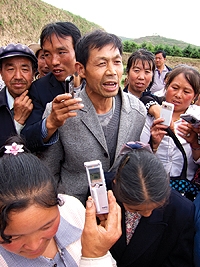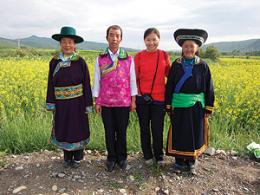
Annual gifts to the UH Mānoa Arts & Sciences Expanding the Student Experience Fund have allowed undergraduate and graduate students to pursue extracurricular research in their fields.
At the end of their research travel/activity, students write a report. We are happy to share Man “Beryl” Yang's report. Yang is a PhD student of ethnomusicology. Her work is an example of the kinds of research supported through the Expanding the Student Experience Fund.
Dear Arts & Sciences Award Committee,
Thank you very much for your generous support for my preliminary dissertation fieldwork this summer from May 17 - July 28. With your funding, I was able to travel to Beijing, China, as well as various locations in three Northwestern provinces, namely Xinjiang Uyghur autonomous region, Qinghai and Gansu.
My dissertation research is about UNESCO's and China's programs for recognition and protection of Intangible Cultural Heritage (ICH). For this purpose, I have chosen to focus on Hua'er, a grassroots folksong tradition, as a case study. Hua'er is the only genre of its kind, in that nine different ethnic groups share the singing tradition: namely the Han, Hui, Tibetan, Tu, Mongol, Dongxiang, Salar, Bonan, and Uyghur ethnicities. These ethnic groups are spread across four northwestern areas in China, including Qinghai, Gansu, Ningxia and Xinjiang.
This Northwestern region is an important area for China, as it is one of the most ethnically diverse areas of China and accounts for almost one third of Chinese territory. This trip was the most fascinating fieldwork experience I have had, traveling about ten weeks across regions with elevations ranging from about sea level to 2,700 meters, daily temperature ranging from 48 to 98 degrees Fahrenheit, and sunset times ranging from 7:00 to 10:30 PM. During this trip, I could be wearing shorts and a t-shirt in the Gobi Desert one day, and sweaters and long pants in the grassland or glacial mountain regions the next day.
During this two-month period of fieldwork, I started in Beijing by meeting with senior researchers and professors and establishing points of contact in the Northwestern regions. I also visited departments in various universities, the China Academy of Social Sciences, and the China Arts Research Center, which also is the headquarters for the National Intangible Cultural Heritage Center.

Man Yang at Danma Tu ethnicity
Hua'er festival, Qinghai province
(photo by Man Yang)
After making these connections, I traveled to three different cities (Urumqi, Lanzhou and Xining), four counties (Min, Kangle, Datong and Huzhu) and a number of villages in the Northwestern region to meet with ICH inheritors, government officials, Hua'er scholars, and researchers.
I was also able to attend four UNESCO-designated Hua'er festivals, namely the Lianhua Mountain Hua'er festival, the Erlang Mountain Hua'er festival, the Laoye Mountain Hua'er festival and the Danma Tu ethnicity Hua'er festival. I met with and interviewed five nationally, provincially or locally designated inheritors of Hua'er; 13 governmental officials who work in local cultural department and ICH centers; 17 Hua'er researchers and scholars; and 17 professional and amateur Hua'er singers. With them, I conducted over 100 hours of interview, and received 37 valuable books and journals on Hua'er, most of them gifts from their authors, as well as 17 CDs and VCDs of Hua'er songs. One of the academic journals I received about Hua'er was published in 1986 that is difficult to find even in Chinese research libraries. I also recorded more than two hours of video footage, four hours of audio recordings and took hundreds of photos.
Not only have I collected the most up-to-date information on ICH in China, but I have also gained insights into the complexities of contemporary ethnic minority identities, politics, and cultural policies in a multicultural and contemporary Chinese context.
During my fieldwork, I also received notice that an abstract of mine based on this line of research was accepted to one of the most prestigious conferences in my field, the Society of Ethnomusicology Conference, which will be held in Philadelphia, Pennsylvania, this November. This conference will mark the first time I will be presenting this research to an audience of American scholars.
Thank you very much again for your generous support!
Sincerely,
Man Yang
"The outcomes of this preliminary fieldwork are far beyond what I had planned for, and will be invaluable for continuation of my research as I begin my dissertation writing in 2012, given the amount of data that I was able to collect so far.
This fieldwork trip will also have a significant impact on the fields of Chinese studies, since Chinese ethnography and Hua’er studies are still fields that are in their infancy."
– Man Yang
This story was originally published in Ke Kumu ʻIke, the Newsletter of the Colleges of Arts & Sciences, UH Mānoa.
Questions? / More Information
If you would like to learn how you can support UH students and programs like this, please contact us at 808 376-7800 or send us a message.